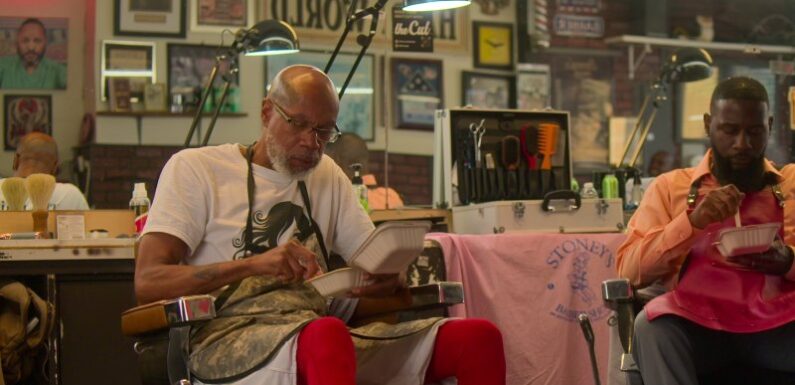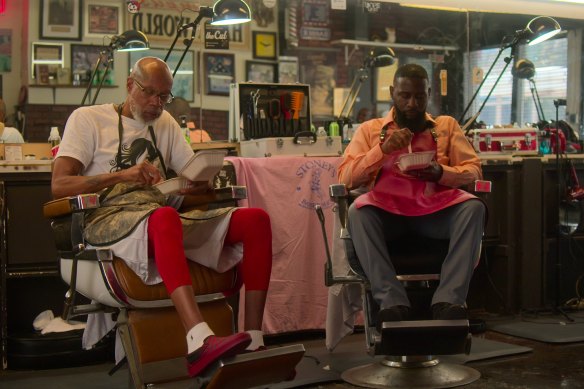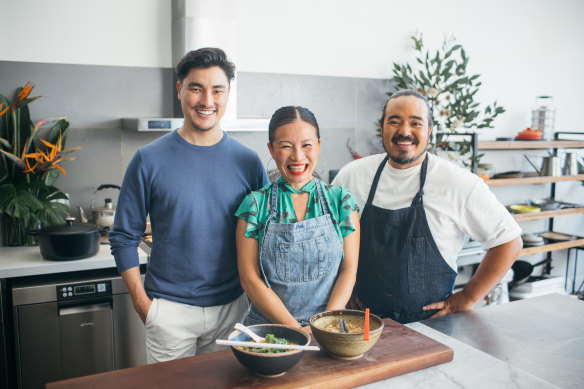
Save articles for later
Add articles to your saved list and come back to them any time.
Around this time of year, you’re probably engaging with food quite a lot. When I say “engaging” I don’t just mean “shovelling handfuls of pavlova into your mouth…” though I do sort of mean that too. I mean that you’re probably engaging with food content. More than usual, anyway.
High on the Hog: How African American Cuisine Transformed America: visually beautiful and very moving.Credit: Netflix
Your phone storage is probably clogged with screenshots of stuffing recipes from the internet. That drawer in the kitchen – you know, the Everything Drawer that contains odds and ends from your entire life, the one that makes you look like a serial killer in Law and Order – is probably crammed with torn out Christmas dishes from those free magazines you get from the supermarket. You likely have a YouTube video or two queued up on gravy technique (note: How to Make Gravy will yield a very different result). Most of all, there’s a huge chance that for weeks, you’ve been watching Jamie Oliver demonstrate turkey hacks, ham hacks, roast potato hacks, fruit cake hacks and avoiding your in-laws hacks (not really) on TV. “Be brave!” Jamie yells, while wielding a cleaver and piffing a leek and a clementine at a goose carcass. ’Tis the season for food TV!
Lately, though, I’ve found myself less drawn to the instructional kind of food programming. (Though, I’m still a sucker for watching Nigella make dishes like “breakfast trifle” that look so surreally delicious it’s like I’ve dreamed them up.) I’ve been watching food shows that aren’t actually about cooking.
A few weeks ago, Netflix dropped season two of their underrated documentary series High on the Hog: How African American Cuisine Transformed America. Hosted by food writer, chef and sommelier Stephen A. Satterfield and inspired by the book of the same name by culinary historian Jessica B. Harris, the show is a sprawling exploration of the birth of African American food from the era of slavery to today. Cooking shows often reduce African American cooking to soul food traditions, but this is a more complex look at the people behind a cuisine who rarely get acknowledged.
Satterfield begins the first season in Benin in West Africa, earnestly being led through vibrant open air markets by Harris, and discussing how ingredients like okra and yams (which aren’t really yams) made their way into American cooking. Back in the US, he talks to chefs and historians about how quintessentially American dishes like mac and cheese and barbecue were created by African American communities – and how much enslaved chefs like James Hemings (chef to Thomas Jefferson) and Hercules (chef to George Washington) changed what the upper classes in the US wanted to eat. He shows the audience how when forced to only use undesirable ingredients, African American people somehow created delicious and nourishing food from almost nothing – which takes him to Texas, to learn about black cowboys in the 1800s. It’s a story of creativity and resilience.
The show is visually beautiful and unsurprisingly, given the subject matter, very moving – I got choked up quite a few times in the first few episodes, and it had nothing at all to do with cutting up onions. Satterfield tracks the journey slaves from Benin would have taken from West Africa, to where his ancestors likely entered Charles Town in South Carolina, “the capital of the nation’s slave trade”. In the present day, we meet families who have lived in communities for generations, being forcibly removed from their homes and crops to make way for a highway. We meet young chefs determined to tell the story of how black cooks were the architects behind fine dining in the US.
Remy Hii, Poh Ling Yeow and Adam Liaw in Adam and Poh’s Malaysia in Australia.Credit: SBS
High on the Hog is a food show, that’s really a history show told through ingredients – much in the same way that Anthony Bourdain’s beloved and influential series No Reservations was a food show that was also a travel show. What both shows have in common is the belief that food doesn’t exist in a void: it is shaped by politics, environment, technology, race, wealth, power and a whole lot of other cultural factors that mean looking closely at a dish tells important stories. Food is art and is also mundane, it’s intimate and detached all at once.
Closer to home, Adam & Poh’s Malaysia in Australia, which is currently on SBS On Demand, it’s an excellent exploration not just of how Malaysian cuisine was popularised and adopted in Australia, but how native Australian produce can be used in Malaysian cooking. There’s a little bit of cooking in each episode, but it’s also part travel show, part history series – with two of the most delightful hosts in food TV, no less. We see Adam Liaw dive for abalone in Tasmania and learn about how it’s cultivated, and Poh Ling Yeow travelling to a country town in WA called Katanning, who thanks to a population of Muslim Malay people who travelled to work in a halal abattoir in the 1970s, has a vibrant Malaysian food scene. The show is all about food history and how to make delicious Malaysian food at home, sure. But it’s also about Australian identity, how food can create community and understanding better than almost anything else. I look forward to digging into their latest series Adam & Poh’s Great Australian Bites on the Christmas break, discovering even more local stories behind the dishes.
Find out the next TV, streaming series and movies to add to your must-sees. Get The Watchlist delivered every Thursday.
Most Viewed in Culture
Source: Read Full Article

